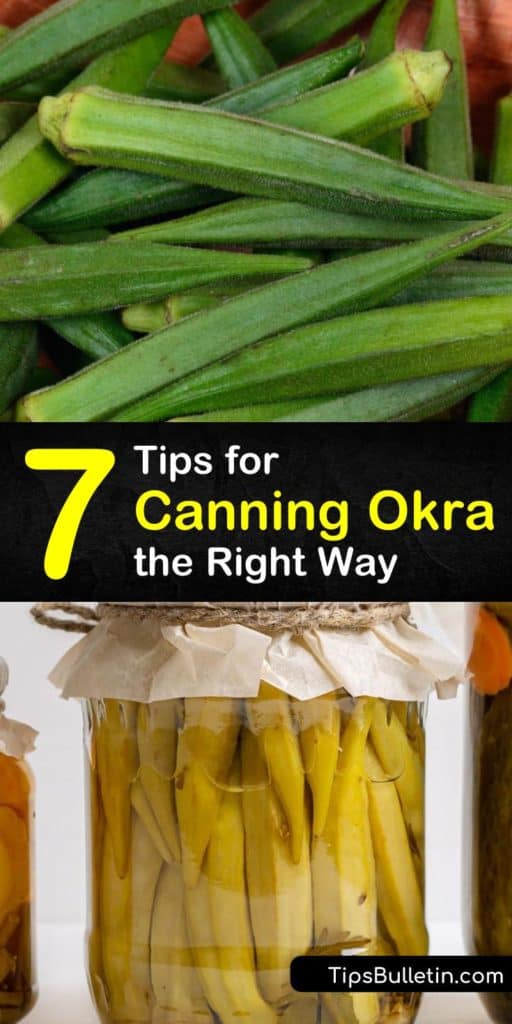Okra is a famous vegetable in the southern United States that adds flavor to gumbo or works as a thickener in soups and stews. Fresh okra only lasts around three to five days in the fridge, but canning okra allows you to preserve it much longer.
Many favorite okra recipes serve it fried, or as fresh snacks, appetizers, side dishes, or salad ingredients. Also known as cactus tea, okra water is the perfect non-slimy alternative to flour when your goal is to thicken soups or sauces.
You could even drink straight okra water 30 minutes before eating a meal to slow your glucose uptake, which is helpful for people with diabetes. The vegetable is also full of health benefits.
Okra is high in fiber to help you digest food, may help you feel full longer, lose weight, and fight common daily ailments like fatigue and stress. Use our guide to learn how to can okra the right way and see our favorite okra recipes below.

Equipment for Canning Okra
Okra is high in fiber to help you digest food, may help you feel full longer, lose weight, and fight common daily ailments like fatigue and stress. Use our guide to learn how to can okra the right way and see our favorite okra recipes below.
If you have a surplus from the garden or farmers market, there are many ways to preserve okra for later eating. After all, there is only so much you can eat at one sitting.
Freezing okra for frying, drying it for delicious snacks, and canning are the most popular methods. Pickling is another favorite with a zesty twist.
Canning equipment makes the job easier. But for pickled okra, you don’t always need expensive tools. A stove and a large pot can achieve nearly as much.
How to Can Okra and Helpful Tips and Tricks
Preserving okra helps it last much longer. There are two main ways to can okra – pickling okra with vinegar or using your pressure canner. Many people who don’t enjoy the slimy texture of cooked okra prefer pickled okra.

Pickled okra is popular among pickle fans for the flavor. Others enjoy preserving the chopped bits for stews and soups. To make pickled okra, trim the stem ends off the veggies and cook them in boiling water.
Allow your chosen varieties of okra to process in a water bath as if preserving green beans or cucumber pickles. Put it in a canning jar with the white vinegar, leaving one-inch headspace at the top. Place the hot jars in storage after they cool.
Using a canner, on the other hand, is ideal for whole or chopped okra. Find straight, small pieces of okra that are each nearly the same length to place in the canning jar. Add water and store them to add to meals later. Use our canning okra tips and tricks to preserve your veggies longer.
Only Can Young and Tender Okra Pods
The first tip for canning okra or for making canned cucumbers is only to use young and tender okra pods and crispy cukes. Harvest young pods when they are about three to four inches long or around every two days if you grow veggies at home.
Older pods become stringy and won’t improve over time the same way. Always avoid canning rusted pods as well.
Use the Right Amount of Okra
The amount of fresh okra required for canning varies. However, use our approximate guidelines based on averages to preserve the right amount.
There are about 26 pounds in a bushel of US-grown okra, which equals around 16 to 18 quarts of canned okra. Approximately 1.3 pounds of okra is ideal for a pint-sized jar, while closer to two pounds fit in a quart jar.
Add a Few Pinches of Salt
If you like salt, try adding a few pinches to the okra jars before pouring the hot liquid inside. About a ½ teaspoon is perfect for pint jars and a teaspoon for quart jars.
We recommend using canning and pickling salt, which offers finer granules than traditional table salt. Kosher salt is another alternative.
If the salt is pure and has no additives, its safe for canning or pickling okra. Avoid the Morton brand, however, which has anti-caking agents in the salt.
Fill Jars with Either Fresh Water or Cooking Liquid
There are two liquid options to choose from when canning okra. Both work well for pickled or pressure canned okra. According to the USDA in 2015, the best way to can okra is to fill the jars with the same water used for the blanching method.
Start by washing and trimming your okra. Cut the veggie into 1-inch pieces, placing them in a saucepan with hot water. Bring it to a rolling boil for two minutes. Warm the jars and fill them with the hot okra using tongs.
Leave about an inch of headspace, and pour the cooking liquid right on top. Be careful handling the hot jars. Some people prefer to discard the cooking liquid and use fresh boiling water for the final step.
The freshwater helps reduce your chances of home-canned okra turning into slimy globs. Boil okra in water for two minutes, then drain the pot. Fill canning jars about an inch from the top with your veggie. Ladle in hot water to cover the okra pieces.
If you don’t use enough liquid to cover the veggies, the food may become discolored or float in the jars. Pack okra in snugly and use enough liquid to cover the greens fully. The same rule applies when you follow your favorite canned jalapenos recipe.
Add Flavoring into the Jars before the Okra
Boost the flavor of your pickled okra using onions, garlic, salt, lemon juice, or a few fresh lemon slices in the bottom of the jar. You may also add red pepper flakes or ½ teaspoon of chili pepper or powder for hot and spicy pickled okra.
Canned or frozen okra also pairs well with green bell peppers, tomatoes, onions, or garlic cloves. Simmer the veggies together for a few minutes before canning them.
Always Remove Air Bubbles to Seal Canning Jars
When canning veggies, always remove the air bubbles before sealing the jars shut. No matter how diligent you are, a few tiny pockets of air are inevitable.
Otherwise, the trapped pockets of air create more pressure as it processes, prevents liquid from covering the okra, and causes sealing issues. Missing this step causes the food to spoil.
Use a plastic knife or plastic, wood, or rubber spatula to press the food inside of the jar. Even the air bubbles you didn’t see will release, and you can place the lid on the jar next. For a tight vacuum seal, make sure the inch of headspace is available.
If the air bubbles reform during processing, the liquid may not fully cover okra. The jar will discolor and be unattractive. Try refrigerating the jars as soon as possible.
Never use metal utensils or knives for this step. The material scratches and breaks glass jars, especially until the jars return to room temperature.
Wipe Jar Rims Clean
Before storing the cans, wipe jar rims clean using a damp paper towel. The jar rims, lid, and outside of the glass jar should remain clean in storage, or you might attract hungry scavengers. Removing the rings also prevents rust from long-term storage jars.
The Best Canning Okra Recipe
Fried okra is among the most popular okra recipes. Use these directions to can okra for frying later.
To can okra that you later fry, collect all the ingredients in a pot on the stove. Boil the water, then immediately remove it from the heat. Avoid cooking the okra thoroughly.
Heat the jars and lids before filling them until there’s about an inch headspace left. Wipe jars and seal them to process for around 40 minutes.
Ready to fry the canned okra? Dump the contents of the jar directly into a strainer. Don’t rinse. Toss the okra in cornmeal, then fry it.
The Best Pickled Okra Recipe
Pickling okra makes excellent snacks and side dishes. The process is simple, even for beginners to follow. It’s similar to making cucumber pickles or green bean pickles, and they may last for over two years with proper storage.
To make pickled okra, wash the freshest looking okra, draining the water and trimming the ends. Leave the head intact. Add the water, salt, and apple cider vinegar to a pot and boil the mixture for three minutes.
Arrange the okra in your canning jars by packing them tightly with the garlic, bell pepper strips, dill seed, and other seasonings. Leave an inch of headspace, and pour the brine into the jar rim.
Use a pressure canner next or cook the okra in a hot water bath to decrease bacteria growth. A canning pot with boiling water helps. Fill the jars in a canning rack, pouring the boiling water to cover each jar’s lid.
Process them for 15 minutes and use a jar lifter to remove them from the pot. Leave the jars to cool on the countertop at room temperature before sealing the lids in place.
Alternatively, some people skip the hot water bath to refrigerate pickled okra. Boil the same ingredients, adding the onions and peppers to the jars with the okra right before pouring the brine inside. Allow the jars to cool and refrigerate them for up to a few weeks.

What’s your favorite okra recipe? We love to hear from fans. If you found our canning okra tips and tricks helpful, please feel free to share our ideas about canned okra on Pinterest and Facebook.